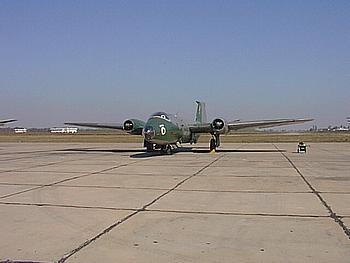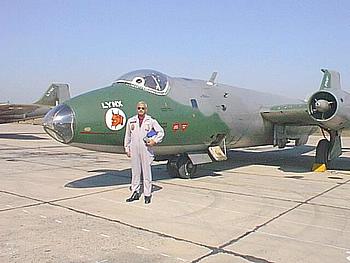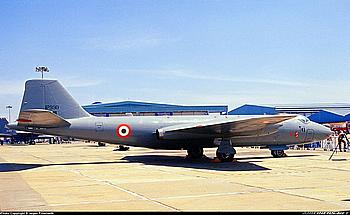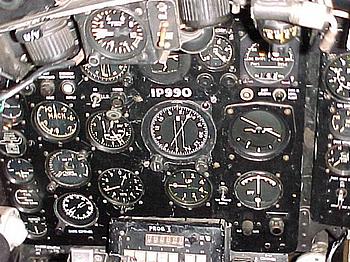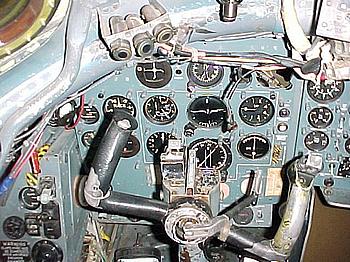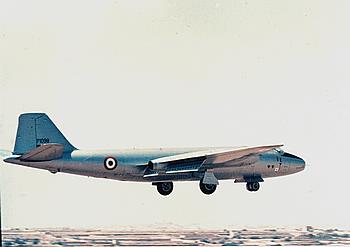The Indian Air Force had a great deal of experience in tactical reconnaissance during WW II. A large majority of the squadrons during the early part of the war operated Hurricane fighters fitted with oblique cameras in the “Tac-R” role in the Burmese theater. The IAF did not have any photo reconnaissance (PR) aircraft for photography of strategic targets or photo survey till after independence. 1 PR Flight (later 101 Sqn) acquired Supermarine Spitfire PR Mk XIXs to give some capability in this area. There had been plans to induct De Havilland Mosquitos late in WWII but problems with the structural integrity of the wooden structure meant that the Mosquitos were not introduced. The glues used in those days came apart in the hot and humid climate of India.
The Indian Air Force had a great deal of experience in tactical reconnaissance during WW II. A large majority of the squadrons during the early part of the war operated Hurricane fighters fitted with oblique cameras in the “Tac-R” role in the Burmese theater. The IAF did not have any photo reconnaissance (PR) aircraft for photography of strategic targets or photo survey till after independence. 1 PR Flight (later 101 Sqn) acquired Supermarine Spitfire PR Mk XIXs to give some capability in this area. There had been plans to induct De Havilland Mosquitos late in WWII but problems with the structural integrity of the wooden structure meant that the Mosquitos were not introduced. The glues used in those days came apart in the hot and humid climate of India.
The PR version of the Mosquito would have given the Indian Air Force the PR capability it needed for that era. Perhaps it is fitting that the IAF relied on the “jet age Mosquito”, the Canberra, for its PR capability!
There were some attempts to give PR capability a boost beyond the piston engine Spitfires, and HAL converted at least 5 Vampire T.55s with cameras in the nose, dubbing them Vampire PR 55s. These Vampires operated with 101 Sqn (which was raised from 1 PR Flight) and 108 Sqn. The Vampires did give a limited PR capability but obviously something better was required.
The Canberra had the range, speed, altitude capability and payload to be an outstanding Photo Reconnaissance (PR) aircraft. Sure enough, the RAF called for a PR version to be built and the first PR version was the Canberra PR Mk 3. The PR.3 was based on the Canberra B.2 bomber with Avon 101 engines. It had a lengthened forward fuselage (by 14”) and the fuselage accommodated a camera bay, flare bay and an additional fuel tank. The crew was limited to two, pilot and navigator unlike the B.2 which had 3 crew (pilot, navigator observer and navigator plotter). Otherwise the PR.3 was very similar in performance, save for longer range, to the B.2
As the B.6 evolved from the B.2, with more powerful engines (the Avon Mk 109 RA 7) and more fuel capacity – so did the PR.7 evolve from the PR.3. The Canberra PR.7 was to the PR.3 as the B.6 was to the B.2. The PR.7 had the integral wing tanks, engine anti-icing and “Maxaret” anti-skid brakes that were introduced in the B.6 version. The more powerful engines gave it a higher service ceiling than the first generation Canberras and the ability to carry more fuel and/or payload. The PR.7 had an additional ventral fuel tank of 417 gallons capacity in the fuselage that gave it more range than the bomber versions.
The only unit to operate PR Canberras in the Indian Air Force was the newly raised 106 Flight which was raised with 5 Canberra PR.57s in May 1957. After the amalgamation of 102 Survey flight which had 3 Dakotas, 106 Flight became 106 Squadron in 1959. 106 at various times has had the appellation “Strategic Photo Reconnaissance” (SPR) or “Strategic Reconnaissance Squadron” (SRS) applied to it.
The PR.57s differed from the RAF’s PR.7s in equipment fit – they had autopilot, radio altimeters and improved navigation kit –which were not standard on the PR.7. The navigation and other equipment are detailed the sections following.
One of the most visible PR.57s in the IAF was IP990 (which is shown in the photograph below). This was the PR.57 that was struck by a missile during the Kargil War. Sqn Ldr Perumal felt an explosive thud on 21 May 1999 while on a PR sortie over the war torn mountainous sector. A Stinger missile had hit the left engine of IP990. Sqn Ldr Perumal and his navigator Flt Lt Jha carried out a skillful landing at Srinagar airfield. Perumal was awarded a well deserved Shaurya Chakra much later (in 2006).
106 Squadron ground crews spent four days attending to IP990 at Srinagar. Wg Cdr Bhalla then ferried IP990 to Agra from Srinagar after its engine, jet pipe and shroud were replaced. Unfortunately IP990 was lost with both crew at Agra in December 2005 during a bad weather single engine approach.
The cameras on the PR.57/67
The PR.57/67 could carry up-to 7 cameras in various arrangements, all verticals. The PR.57 cameras consisted of the F-49 vertical camera as the master camera and a fan of 4 or 6 F-52 cameras. The F-49 was the “master vertical camera” but was replaced by the Carl Zeiss RMK 15/23. The F-49 camera was mounted vertically in the rear fuselage camera bay exposing a 9 inch by 9 inch negative. The RMK is however mounted in the flare bay and not the rear bay that housed the F-49.
The F-52 camera
The F52 camera is the standard tactical camera which both the PR-57/67 carry. The F-52 “fan” cameras are carried in the 6 fan camera bays of the PR.57/67 numbered f-1/6, f-2/6, f-3/6, f-4/6, f-5/6 f-6/6, with 1 to 3 on the port and 4 to 6 on the starboard side of the aircraft.
When four fan cameras are carried, then a 20” focal length is used. With a forward overlap of 60% the fan of four covers the complete area of the RMK in 4 x 4 = 16 exposures.
With a fan of 6 F-52’s, a 36” focal length lens is used. In this configuration they cover slightly less than the area of the RMK by exposing 6 x 6 = 36 photographs.
By overlapping coverage, when viewing overlapped pictures through a stereo viewer, photo-interpreters get a “3-D” view of the target area.
The format of the F-52 exposures is 8.5” x 5”. A private company Matrix Mechatronics Pvt Ltd, has modified the F-52, which used a 9” perforated film to accept the 9.5” un-perforated RMK film directly.
The RMK vertical survey camera
The Carl Zeiss RMK Aerial Survey camera was a sensor that added immensely to the Canberra’s capabilities. This replaced the F.49 Mk IV vertical survey camera. The camera is installed in the flare bay of both the PR.57 and the PR.67. Some modifications had to be made to the bay to fit the RMK in the Canberra, which include a special pod with integral temperature control. This entailed the flare bay having cutouts to accommodate the pod and to ensure that it does not shift in the airflow. The pod juts out below the aircraft by a couple of inches.
The RMK does not have interchangeable lenses. The IAF has the RMK 8.5/23 (3.5”) super wide angle, 15/23 (6”), 30/23 (12”) and the 60/23 (24”) focal length cameras. Only the 15/23 is used on the Canberra. The first figure for the RMK stands for the focal length and the second is the format which is 23 cm x23 cm or 9” x 9”. The RMK shoots vertically downwards through a circular window in the lower fuselage. A drop down door provides access to the camera which can be slid on or off rails.
Matrix Mechatronics Pvt Ltd combined the old RMK (FS-II) and F-52 (T-35) control units and replaced both with a single control unit (CDU), slaving the F-52 to the RMK for simplified cockpit workload. The image below shows an RMK with the new control in Matrix Mechatronic’s lab.
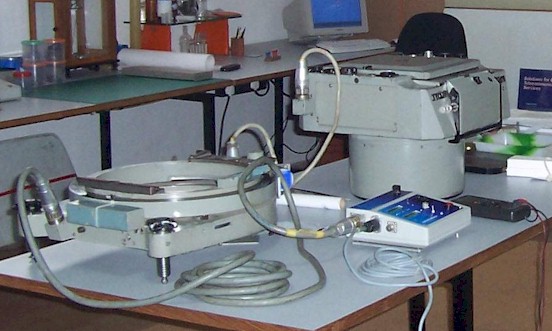 |
| The RMK vertical survey camera |
The RMK is operated by the navigator who can set aperture and shutter speed. Image Movement Compensation (IMC) is applied to the film as it passes over the camera plattern to reduce the effect of relative target movement while camera shutter is open. The IMC equipment uses three light sensors to determine the relative speed of ground movement and the sensed relative speed results in compensating electrical signals applied to the camera to control film movement.
The camera prints level, height and time data in small bubble between each frame of the film. The RMK produces very high quality imagery of great clarity.
The older reconnaissance asset – PR.57
In the PR Canberra crew accommodation is for 2 crew members – the pilot, in an ejection seat under a “goldfish bowl” canopy, sitting towards the left of the aircraft and the navigator who sat behind the pilot in an ejection seat in his own little compartment. The compartment had a “hatch” over the ejection seat that could be jettisoned before an ejection. The ejection seat could also blow through the hatch. Earlier the hatch had to be manually blown for an ejection but later modifications were made for the sequence to be automatic. The pilot could also jettison his canopy or eject through it. The PR.57 was equipped with ejection seats that needed at least 1000 ft and 200 kts for a successful ejection.
The conditions under the goldfish bowl canopy could be awful. The air conditioning was not only ineffective for India’s burning summers; the temperatures were unevenly maintained in the crew compartment. The pilot was usually too hot, due to the greenhouse effect of the canopy and the navigator was too cold in his “black hole” that had just small side windows. The temperature during a hot summer’s day could easily reach 70?C+ if the aircraft had been standing out on the tarmac. For the PR.57 the cockpit temperature is generally 18? C above ambient temperature!
There was not much relief to be had in the cool higher altitudes, because heat turned to miserable cold. The navigator’s compartment was so cold, that the pilot had to compromise by setting the heat control fully hot, even if he was uncomfortable. Wg Cdr Vineet Bhalla, probably the Canberra pilot with the most number of hours on type (4000+) in the IAF, remembers that the floor of the Canberra used to have ice forming on it after an high altitude PR sortie. Wg Cdr Bhalla describes a sortie in a PR 57 in which he was a passenger and had a senior officer (who was Canberra qualified) flying. The navigator, who had to occupy the nose position throughout the flight, had a constant silent tussle with the senior officer over the hot/cold air mix control! The senior officer had set the heat for his comfort at mid-range heat without regard to the physiological needs of Bhalla and the navigator, who were freezing!
The entry door was to the right, like in all Canberra marks in the IAF. There was a “crawlway” on the right side, which gave access to the nose position. The nose position was usually occupied by the navigator during the run in over the target. The navigator un-strapped and lay down on a cushion in a prone position in the nose. The position has “grab handles” so that the navigator could hang on for dear life if the Canberra was tossed around by turbulence or evasive action by the pilot. There were camera controls duplicated from the navigators station to the nose and there was Doppler read out of drift and speed in the nose station. Over the flat portion of the nose transparency was a “banana sight” which was a sight used to track photo targets. There was second oxygen regulator at the nose position and the navigator had to carefully unhook from the regulator at his station and carefully hook up to the regulator in the nose!
The navigation equipment included “Green Satin” which was a Doppler radar based drift and groundspeed measuring instrument. It gave the navigator an accurate measurement of the drift due to the wind. Ground speed and drift are directly measured by the Doppler (i.e. they are not based on true airspeed calculations which can be error prone). From the airspeed and compass, it was able to deduce the wind speed.
The PR.57 had a “Ground Position Indicator” (GPI) Mk.4. GPI indicated the latitude and longitude of the aircraft and its relationship to a target point on the ground, and was fed by “Green Satin”.
The PR.57 also had a “radio compass” which was a device that measured the direction that radio waves were coming from in relation to the aircraft. In more standardized form, this equipment is known as ADF (in conjunction with an NDB) in civilian aircraft. The radio waves could come from a beacon which was on a well known position on the ground. By finding at least two such beacons and intersecting the lines drawn from the aircraft to the beacons, a “fix” on the aircraft position could be found. The radio compass worked very well with any AM radio broadcast station as a “beacon”, and that is why All India Radio transmissions were interrupted in wartime!
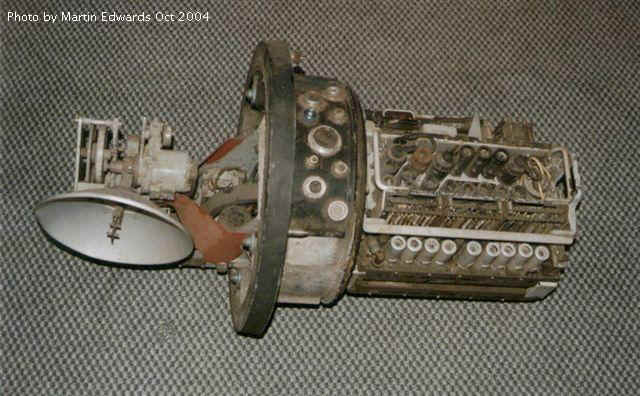 |
| Orange Putter tail warning radar (Martin Edwards) |
“Orange Putter” – was tail warning radar on the PR.7. The British gave their avionics delightful codenames, in contrast to the serious “Pave hawk” like codenames given by the Americans. Basically “Orange Putter” was radar that projected its beam backward from the Canberra, so if an enemy aircraft attempted to sneak up behind it to shoot it down, the radar could warn the crew about it. Unfortunately it wasn’t always reliable, and often gave spurious warnings. This had the effect of raising blood pressures of the aircrew – and at least one vital photo reconnaissance mission was called off because of spurious “Orange Putter” warnings. These spurious warnings resulted in an erroneous intelligence estimate of an enemy fighter force existing where there was none, during the 1961 Goa operations! Another Canberra sortie had verified that there were in fact no fighters anywhere to be seen!
The other drawback of “Orange Putter” was that it was an active system, i.e. it radiated radar energy. As many a Mosquito night fighter and intruder crew found to their misfortune in WWII, this lead properly equipped enemy fighters to them like moths to a flame.
The PR.57 had provisions to carry “photo-flashes” which were pyrotechnic flares used for illumination during night photography. These flares were carried in the flare bay of the PR.57. The flash pack had an illuminating capacity of 1,000,000 (1 Million) Candlepower. Of course, the flares not only illuminated the ground for the Canberra to see, but also illuminated the Canberra for anyone else to see! Tactically, it would have been extremely hazardous to use the flash pack!
There was also a radio altimeter in the PR.57. It was the same radio altimeter that IAF Dakotas had! According to Wg Cdr J Thomas, Edwards trained test pilot and CO of 106 Sqn “The radio altimeter was useless deadweight though it may have been state of the art for the end of the war (WWII)!”.
The PR Mk 67 – the “modernized” PR Canberra
More than thirteen years after placing the original order for photo reconnaissance Canberras, the IAF placed an order for a further two reconnaissance Canberra versions in October 1969. This order was placed at the same time as the order for a better equipped bomber version the Canberra B(I)66 (see the section on the B(I)66). Two RAF PR.7s were upgraded by the factory to PR.67 standard and were delivered to the IAF in August 1971. The PR.67 was similar to the PR.57 in most respects but had upgraded avionics. The reconnaissance fit of the Canberra PR 67 was updated from the original fit of the PR 57. This included UHF and HF radios, together with a Doppler roller map with feed-in from a Doppler navigation system, the AD-560. The AD-560 had the added advantage that it was fitted on the Boeing 707s operated by Air India! The navigational system was intended to give more accurate navigation when flying without navaids on the ground. The Canberra PR. 67 has otherwise identical capabilities as an airframe to the PR.57.
The AD-560 was an example of an early analog navigation computer. Miles to go and course had to be dialed in by the navigator for a leg. The miles-to-go dials were rotated back towards Zero electrically in proportion to the ground speed measured by the Doppler Radar. X-track distance was displayed with the LOC/VOR needle on the RMI, a separate instrument. The advantage the Doppler radar has is that it is a completely self contained system, and did not need any satellites, ground stations or any other navigational aids outside the aircraft to function. The AD-560 was based on the same principles as Green Satin, but was much simpler to operate, with a high degree of automation that must have been comforting to the navigators! The Doppler could be coupled to the autopilot (as with the Green Satin of the PR.57).
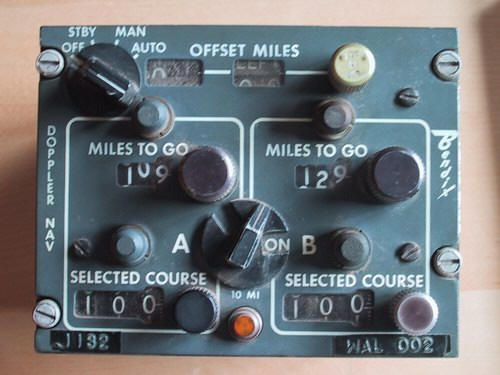 |
| AD 560 doppler nav system readout |
The PR.67 had radar altimeters, with built in altitude alerts, that functioned a lot better than the Dakota radio altimeters of the PR.57!
To add to the confusion of the crews, the PR.67 had different ejection seats than the PR.57. The crew positions were identical to the PR.57 but it had upgraded ejections seats for both pilot and navigator. The seats were Martin Baker 2CA Mk 2s – which had a 0/90 envelope – i.e. they would function at a minimum altitude of 0 feet if the speed of the airplane was a minimum of 90 kts. The seats for the PR.57 had an envelope of 1000/200. In an emergency the crew had to keep all these figures in mind. No wonder Wg Cdr Bhalla states, “I cannot think of ejecting from the Canberra!! You ask a Canberra crew, and their answer would invariably be the same… Incidentally, we have five different ejection seats in the present Canberra fleet, with different ejection procedures. How many of us would actually be able to carry out a safe ejection as a result of that?”
The success of the PR Canberras
The photo reconnaissance Canberra is an unqualified success with the Indian Air Force. Paraphrasing one of the early COs of 106 Sqn, Wg Cdr “Jaggi” Nath (incidentally with Mahavir Chakra and bar in two different conflicts he was also one of the most highly decorated IAF officers)– “106 Squadron (with the Canberra PR.57/PR.67) was not just an Air Force asset, it was a national asset”. 106 SR squadron was indeed an elite squadron. It is the most decorated squadron of the IAF, even though its aircraft and aircrew strength is half that of bomber and fighter squadrons. The 106 Squadron Canberra flight (it has a flight of H.S. 748 “Avro” PR modified aircraft as well) with just five aircraft and no trainer would more often than not fly more hours than the Canberra bomber squadrons which had 16 bombers and 2 trainers.
Both in war and peace, the PR.57s and PR.67s were used for gathering intelligence and information. They took photographs of enemy installations, mapped India from coast to coast and head to toe, took photographs of ships at sea and of enemy redoubts in the high mountains. Building on the foundations set by the pioneers of 101 Sqn and 108 Sqn, 106 sqn with its PR.57s/PR.67s built a professional PR and survey organization which spanned many generations of IAF personnel. The only other dedicated strategic PR squadron in the Indian Air Force was 102 Squadron with its tri-sonic MiG-25s. The MiG-25 was a more survivable reconnaissance asset but could not match the Canberra’s versatility and simplicity of operation. The integration of the second crew member also gave the Canberra capabilities that the MiG-25 did not have. Perhaps that is why the MiG-25 has already been retired, despite entering service more than 20 years after the Canberra, while the Canberra still soldiers on.
|
Canberra PR Mk 57 / 67 characteristics |
|
| Engines | Rolls Royce Avon Mk 109 (RA 7) rated at 7500 lbs (2948 kg) thrust |
| Accommodation | One pilot and one navigator in ejection seats |
| Ejection seats | PR.57 : Martin Baker 2CA1 Mk 1 (pilot) and 2CA2 Mk 1 (navigator) PR.67 : Martin Baker 2CA1 Mk 2 (pilot) and 2CA2 Mk 2 (navigator) |
| Total fuel capacity | 3305 gallons |
| Operational equipment | VHF (ARI 5490) ILS (ARI 18011) and Zero Reader IFF Mk 10 (ARI 5848) Radio Compass (Marconi AD7092D) Radio Altimeter AYF (ARI 5284) Orange Putter (ARI 5800) Green Satin (ARI 5851) Radar Altimeter (PR.67 only) AD-560 Doppler navigation system (PR.67 only) Autopilot |
| Basic empty weight / MTOW | PR.57 – 25000 lbs/48000 lbs PR.67 24850 lbs/ 48000 lbs |
| Indian Air Force Canberra PR 57/PR 67 serial numbers | |||||
| Mark | Particulars | Year | Nos | S.No | Remarks |
| PR.57 | Initial order diverted from RAF | 1957 | 3 | IP986 IP987 IP988 |
ex-WT539 ex-WT542, to NRSA as VT-EEM ex-WT541 Shot down 10 Apr 1959 |
| PR.57 | Initial order new build | 1957 | 5 | IP989 IP990 IP991 IP992 IP993 |
Crashed 19 Dec 2005 |
| PR.57 | Attrition replacements | 1963 | 2 | BP745 BP746 |
|
|
PR.67 |
New order, upgraded PR 7 | 1971 | 2 | P1098 P1099 |
ex-WH800 ex-WJ816 |
Total : 12
